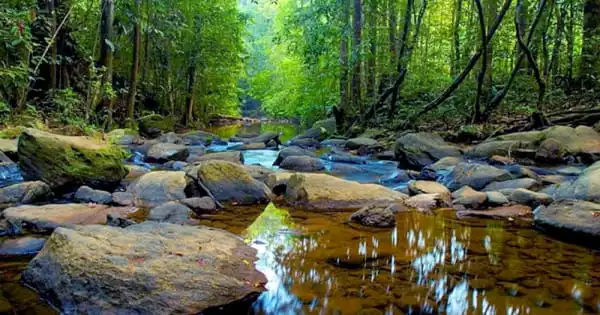Description
Sinharaja, in southwest Sri Lanka, is significant because it represents the country’s last substantial sustainable stretch of primary tropical rainforest, which formerly covered the whole island. All of its trees are indigenous to the area, with 64 percent being uncommon. The reserve also houses 23% of Sri Lanka’s unique creatures, including 85 percent of the country’s endemic birds and more than half of the country’s endemic mammals, reptiles, and butterflies.
The Sinharaja Rain Forest is located in the island’s southwestern region and encompasses an area of 11,187 hectares (hectares). The Sinharaja Forest Reserve is bordered on three sides by the island’s three districts: Galle, Matara, and Ratnapura. The Rakwana Massif, with its mountain ranges, is part of Sinharaja’s territory.
Plants & Animals
The forest is home to a diverse range of butterflies, including magnificent blue morphos and bird-wings that flutter over the canopy like windblown paper. Lizards abound, and the area is home to several unique endemics. Because of the dense foliage, sightings of many animals in Sinharaja are always a question of chance. The terrible screaming sounds of male purple-faced leaf monkeys, on the other hand, signal their arrival.
The rufous-bellied eagle, mountain hawk, black, crested serpent, and Rufous-bellied eagle are among the endemic birds found in Sinharaja. Crested goshawks, Sri Lanka spurfowls, Layard’s parakeets, red-faced malkohas, green-billed coucals, Malabar trogons, brown-backed needletails, chestnut-backed owlets, Yellow-fronted barbets, black-crested bulbuls, Yellow-browed bulbuls, spot-winged thrushes, orange-billed babblers, ashy-bre Even in the middle of the day, you could see one of the mixed-species ‘bir” waves,’ which generally include crested drongos, Malabar trogons, red-faced malkohas, blue magpies, and a variety of other species.
Common Factor
Three major characteristics must be present in tropical rain forests. First, there must be plenty of brilliant sunlight; second, there must be a lot of rain, evenly spread throughout the year; and third, there must be a lot of heat. As a result, the area becomes extremely humid. Only Sinharaja and a few other dispersed forest areas with smaller land areas in Sri Lanka’s southern western region meet the aforementioned requirements. There is also a valid reason why Sinharaja is a virgin forest, yet the woods in the north of the island are not. Sri Lanka has been an agricultural country since the 4th century BC, and much of the land in the country’s north-central region, where forest covers presently exist, was under plow until approximately the 10th century AD. Therefore, the age of the forest cover there is just a thousand years or so.

Climate
The northeast monsoon, which occurs from November to January, and the southwest monsoon, which occurs from May to July, both bring rain to the forest. Almost majority of it falls within the isohyets of 3810mm and 5080mm. The average annual rainfall is approximately 2500mm, with no dry spells: even the driest month, February, receives 189mm on average. Temps fluctuate between 19°C and 34°C, with minimal seasonal change but a large diurnal range: temperatures fluctuate between 19°C and 34°C, although the impact is mitigated by the regular rains.
Few Facts About Sinharaja Rain Forest
The creation of the Sinharaja Rain Forest in Sri Lanka and how it came to be are both fascinating topics. At the time, there were three big rainforest regions known as the Amazon, African, and Far Eastern. However, these vast swaths of rainforest dwindled in size and were eventually restricted to smaller places.
- The world’s current rain forests are an evolution of older rain forests that date back 150 to 200 million years.
- During the Paleosoic era, around 140 million years ago, a portion of territory from the Southern Hemisphere called Gondwana land, which included present-day India and Sri Lanka, began the long process of splitting from the main continent.
- Around 55 million years ago, during the Cretaceous period, a geographical mass known as the Decan plate, which divided the Southern hemisphere from Sri Lanka and India, began sliding towards the equator and joined the Northern hemisphere known as Laurussia.





